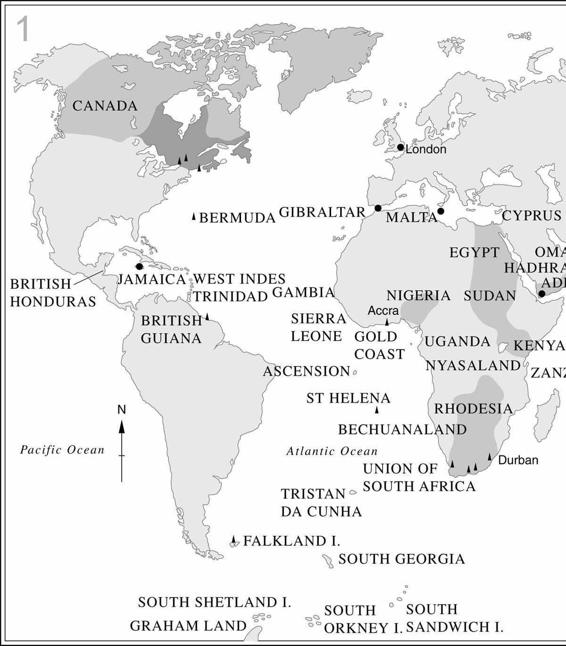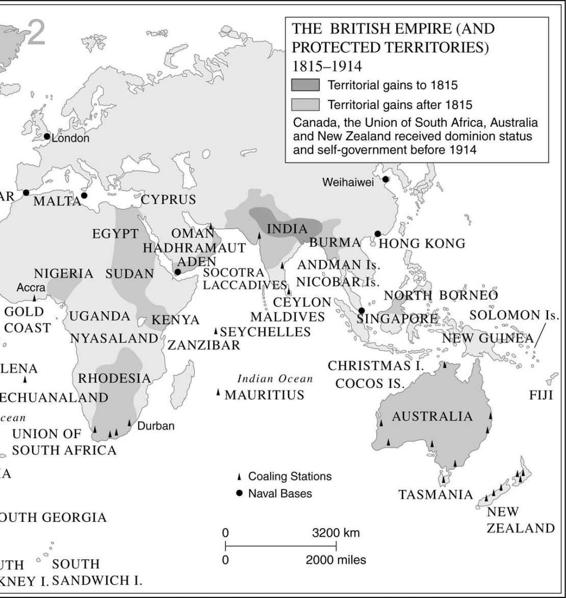The New Penguin History of the World (147 page)
Read The New Penguin History of the World Online
Authors: J. M. Roberts,Odd Arne Westad

This process would not be completed before the twentieth century, but it soon brought other changes in the nature of British politics. Slowly, and somewhat grudgingly, the traditional political class began to take account of the need to organize parties which were something more than family connections or personal cliques of members of parliament. This was much more obvious after the emergence of a really big electorate in 1867. But the implication – that there was a public opinion to be courted which was more than that of the old landed class – was grasped sooner than this. All the greatest of English parliamentary leaders in the nineteenth century were men whose success rested on their ability to catch not only the ear of the House of Commons, but that of important sections of society outside it. The first and possibly most significant example was Sir Robert Peel, who created English conservatism. By accepting the verdicts of public opinion he gave conservatism a pliability which always saved it from the intransigence into which the Right was tempted in so many European countries.
The great political quarrel of Corn Law repeal demonstrated this. It was not only about economic policy; it was also about who should govern the country, and was in some ways a complementary struggle to that for parliamentary reform before 1832. By the middle of the 1830s the conservatives had been brought by Peel to accept the consequences of 1832, and in 1846 he was just able to make them do the same over the protective Corn Laws, whose disappearance showed that landed society no longer had the last word. Vengefully, his party, the stronghold of the country gentlemen who considered the agricultural interests the embodiment of England and themselves the champions of the agricultural interest, turned on Peel soon afterwards and rejected him. They were right in sensing that the whole tendency of his policy had been directed to the triumph of the free trade principles which they associated with the middle-class manufacturers. Their decision divided their party and condemned it to paralysis for twenty years, but Peel had in fact rid them of an incubus. He left it free when reunited to compete for the electorate’s goodwill untrammelled by commitment to the defence of only one among several economic interests.
The redirection of British tariff and fiscal policies towards free trade was
one side, though in some ways the most spectacular, of a general alignment of British politics towards reform and liberalization in the central third of the century. During this time a beginning was made with local government reform (significantly, in the towns, not in the countryside where the landed interest was still the master), a new Poor Law was introduced, factory and mining legislation was passed and began to be effectively policed by inspection, the judicial system was reconstructed, disabilities on Protestant nonconformists, Roman Catholics and Jews were removed, the ecclesiastical monopoly of matrimonial law, which went back to Anglo-Saxon times, was ended, a postal system was set up that became the model on which other nations would shape theirs, and a beginning was even made on tackling the scandalous neglect of public education. All this was accompanied by unprecedented growth in wealth, whose confident symbol was the holding in 1851 of a Great Exhibition of the world’s wares in London under the patronage of the queen herself and the direction of her consort. If the British were inclined to bumptiousness, as they seem to have been in the central decades of Victoria’s reign, then it may be said that they had grounds. Their institutions and economy had never looked healthier.
Not that everyone was pleased. Some moaned about a loss of economic privilege: in fact, the United Kingdom continued to display extremes of wealth and poverty as great as any other country’s. There was somewhat more substance to the fear of creeping centralization. Parliamentary legislative sovereignty led to bureaucracy invading more and more areas which had previously been immune to government intervention in practice. England in the nineteenth century was very far from concentrating power in her state apparatus to the degree which has now become usual in all countries. Yet some people felt worried that she might be going the way of France, a country whose highly centralized administration was taken to be sufficient explanation of the failure to achieve liberty which had accompanied the French success in establishing equality. In offsetting such a tendency, the Victorian reforms of local government, some of which came only in the last two decades of the century but drove it further towards democracy, were crucial.
Some foreigners admired. Most wondered how, in spite of the appalling conditions of its factory towns, the United Kingdom had somehow navigated the rapids of popular unrest which had proved fatal to orderly government in other states. Britain had deliberately undertaken huge reconstructions of its institutions at a time when the dangers of revolution were clearly apparent elsewhere, and had emerged unscathed, its power and wealth enhanced and the principles of liberalism even more apparent in its politics. British statesmen and historians gloried in reiterating that the essence of the nation’s life was freedom, in a famous phrase, ‘broadening down from precedent to precedent’. Englishmen seemed fervently to believe this, yet it did not lead to licence. The country did not have the advantages of geographical remoteness and almost limitless land which were enjoyed by the United States – and even the United States had fought one of the bloodiest wars in human history to contain a revolution. How, then, had Great Britain done it?
This was a leading question, though one historians still sometimes ask without thinking about its implications that there exist certain conditions which make revolution likely and that British society seems to have fulfilled them. It may be, rather, that no such propositions need to be conceded. Perhaps there never was a potentially revolutionary threat in this rapidly changing society. Many of the basic changes which the French Revolution brought to Europe had already existed in Great Britain for centuries, after all. The fundamental institutions, however rusty or encrusted with inconvenient historic accretion they might be, offered large possibilities. Even in unreformed days, the House of Commons and House of Lords were not the closed corporate institutions which were all that was available in many European states. Already before 1832, they had shown their capacity to meet new needs, even if slowly and belatedly; the first Factory Act (not, admittedly, a very effective one) had been passed as early as 1801. Once 1832 was past, then there were good grounds for thinking that if parliament were only pressed hard enough from the outside, it would carry out any reforms that were required. There was no legal restraint on its power to do so. Even the oppressed and angry seem to have seen this. There were many outbreaks of desperate violence and many revolutionaries about in the 1830s and 1840s (which were especially hard times for the poor) but it is striking that the most important popular movement of the day, the great spectrum of protest gathered together in what was called ‘Chartism’, asked in the People’s Charter, which was its programme, for measures which would make parliament more responsive to popular needs, not for its abolition.
Yet it is not likely that parliament would have been called upon to provide reform unless other factors had operated. Here it is perhaps significant that the great reforms of Victorian England were all ones which interested the middle classes as much as the masses, with the possible exception of factory legislation. The English middle class came to an early share in political power as its continental counterparts had not and could therefore use it to obtain change; it was not tempted to ally with revolution, the recourse of desperate men to whom other avenues were closed. But in any case it does not seem that the English masses were themselves very
revolutionary. At any rate, their failure to act in a revolutionary way has caused much distress to later left-wing historians. Whether this is because their sufferings were too great, not great enough or whether simply there were too many differences between different sections of the working class has been much disputed. But it is at least worth noticing, as did contemporary visitors, that in England traditional patterns of behaviour died hard; it was long to remain a country with habits of deference to social superiors which forcibly struck foreigners – especially Americans. Moreover, there were working-class organizations which provided alternatives to revolution. They were often ‘Victorian’ in their admirable emphasis on self-help, caution, prudence, sobriety. Of the elements making up the great English Labour movement, only the political party which bears that name was not in existence already before 1840; the others were mature by the 1860s. The ‘friendly societies’ for insurance against misfortune, the cooperative associations and, above all, the trades unions all provided effective channels for personal participation in the improvement of working-class life, even if at first only to a few and slowly. This early maturity was to underlie the paradox of English socialism, its later dependence on a very conservative and unrevolutionary trade-union movement, for a long while the largest in the world.
Once the 1840s were over, economic trends may have helped to allay discontent. At any rate working-class leaders often said so, almost regretfully; they, at least, thought that betterment told against a revolutionary danger in England. As the international economy picked up in the 1850s good times came to the industrial cities of a country which was the workshop of the world and its merchant, banker and insurer, too. As employment and wages rose, the support which the Chartists had mustered crumbled away and they were soon only a reminiscence.
The symbols of the unchanging form which contained so much change were the central institutions of the kingdom: parliament and the Crown. When the Palace of Westminster was burned down and a new one was built, a mock-medieval design was chosen to emphasize the antiquity of what would come to be called ‘the Mother of Parliaments’. The violent changes of the most revolutionary era of British history thus continued to be masked by the robes of custom and tradition. Above all, the monarchy continued. Already in 1837, when Victoria ascended the throne, it was second only to the papacy in antiquity among the political institutions of Europe; yet it was much changed in reality, for all that. It had been brought very low in public esteem by George III’s successor, the worst of English kings, and not much enhanced by his heir. Victoria and her husband were to make it unquestionable, except by a very few republicans. In part this was against the grain for the queen herself; she did not pretend to like the political neutrality appropriate to a constitutional monarch when the Crown had withdrawn above the political battle. None the less, it was in her reign that this withdrawal was seen to be made. She also domesticated the monarchy; for the first time since the days of the young George III the phrase ‘the Royal Family’ was a reality and could be seen to be such. It was one of many ways in which her German husband, Prince Albert, helped her, though he got little thanks for it from an ungrateful English public.



Only in Ireland did their capacity for imaginative change seem always to fail the British people. They had faced a real revolutionary danger and had had to put down a rebellion there in 1798. In the 1850s and 1860s things were quiet. But the reason was in large measure an appalling disaster which overtook Ireland in the middle of the 1840s, when the failure of the potato crop was followed by famine, disease and thus, brutally, a Malthusian solution of Ireland’s over-population. For the moment, the demand for the repeal of the Act of Union, which had joined her to Great Britain in 1801, was muted, the dislike of her predominantly Catholic population for an alien and established Protestant Church was in abeyance and there was no serious disturbance among a peasant population feeling no loyalty to absentee English landlords (or, for that matter, to the resident but equally grasping and more numerous Irish landlords) who exploited tenant and labourer alike. Problems none the less remained and the Liberal government which took office in 1868 addressed itself to some of them;
the only significant consequence appeared to be the emergence of a new Irish nationalist movement, based on the Roman Catholic peasantry and demanding ‘Home Rule’. Dispute over what this might – let alone ought to – mean was to haunt British politics, overturn their combinations and wreck attempts to settle the Irish Question for a century and more. In the short run, it promoted two rival Irish revolutionary movements north and south and contributed to the wrecking of British liberalism. Thus Ireland, after a thousand years, began again to make a visible mark on world history, though, of course, she had already made one less obviously earlier in the century through the emigration of so many of her people to the United States of America.